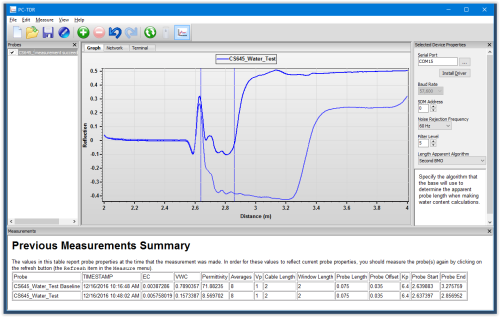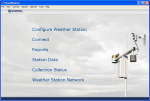PC-TDR Logiciel pour TDR100 et TDR200







Aperçu
Le logiciel PCTDR est utilisé avec nos systèmes basés sur le TDR100 ou TDR200 pour l'installation, la maintenance et le dépannage du système. Il affiche le contenu en eau volumique et la conductivité électrique, il commute les voies des multiplexeurs, recueille la forme d'onde et les fichiers de données dérivés, et détermine des valeurs constantes des sondes, qui sont nécessaires pour la mesure de la conductivité électrique.
Avantages et caractéristiques
- Conçu pour fonctionner avec le nouveau TDR200 tout en restant pleinement compatible avec le Reflectomètre en domaine temporel TDR100
- Compatible avec les versions courantes des systèmes d'exploitation Windows (Windows Vista/7/8/10)
- Générateur de programme CRBasic inclus sur PC-TDR pour les systèmes TDR200 et TDR100, y compris le support des multiplexeurs SDM8X50 et SDMX50, ainsi que les paramètres de sonde par défaut pour toutes les sondes TDR de Campbell Scientific
- Assistant pour l'étalonnage de la sonde pour déterminer les longueurs, les décalages et les valeurs Kp spécifiques à la sonde pour toutes les sondes Campbell Scientific ou autres
- Configuration graphique du réseau TDR basée sur Network Planner, permettant une configuration et une programmation très faciles
- Visualiser les tracés TDR, 1 ière dérivées 1 ou 2 ième dérivées de sondes multiples dans le même graphe
- Basculement rapide de la mesure de base à partir de la vue graphique
- Affichage graphique de la réflexion de début et de fin pour les mesures de la teneur en eau
- Importation/Exportation des données de la sonde TDR en utilisant les formats de fichier TOA5 ou XML
- Permet d'accéder aux nouvelles fonctionnalités du TDR200, y compris la réduction du bruit 60/50 Hz, le filtrage TDR avancé et la possibilité de mesurer jusqu'à 10 112 points de mesure sur une même fenêtre
Images

Produits similaires
Compatibilité
- Le logiciel PC-TDR est utilisé pour les systèmes basés sur le TDR100 ou le TDR200.
- Un système d'exploitation sur ordinateur Windows® Vista/7/8/10/11 est nécessaire pour faire fonctionner le PC-TDR.
- Un port USB disponible est nécessaire pour se connecter au TDR200, et un adaptateur USB-série peut être nécessaire pour se connecter au TDR100.
Spécifications
| Numéro de version | 3.0 |
Téléchargements
PC-TDR v.3.0 (7.34 MB) 15-12-2016
Support software designed for the TDR200 and is also compatible with the retired TDR100 Time-Domain Reflectometer.
FAQ
Nombre de FAQ au sujet de(s) PC-TDR: 10
Développer toutRéduire tout
-
No. A Windows-based computer is required to run PC-TDR.
-
Yes. In PC-TDR, click Settings/Multiplexer and Add Mux.
-
Although slope stability/rock mass deformation users will need to adjust the following PC-TDR default settings, these settings may provide a good starting point:
- Cable VP = 1.
- Waveform Average = 4.
- Waveform Points = 251.
- Waveform Start = 0.
- Waveform Length = 50.00.
Note that the Probe Length and Probe Offset will not be used for a slope stability/rock mass deformation application.
-
To understand the readings obtained from a datalogger program, it is necessary to see how the TDR100 operates in PC-TDR. Either the TDR100 commands are entered in PC-TDR and the user waits to see the results, or the datalogger sends the TDR100 commands and automatically stores the results.
Campbell Scientific suggests initially entering the TDR100 commands in PC-TDR and waiting for the results before writing a datalogger program. This allows verification that the TDR100 is operating correctly in PC-TDR. After that has been verified, a datalogger program can be created for the TDR100 that sends the commands and stores the results.
-
Yes. PC-TDR can send control commands to advance through the channels of a SDMX50-series multiplexer. To do this, select Settings | Multiplexer and then add the multiplexers and probes that match the TDR100 system.
-
Non, à partir de septembre 2014. Le logiciel de support PC-TDR peut être téléchargé gratuitement à partir de la section Téléchargements de la page du produit PC-TDR.
-
There are several possible things that should be considered or verified:
- Verify that there is 12 V dc on the TDR100 green connector. A reading between approximately 10 V to 16 V dc is OK.
- Use a standard RS-232 serial cable to connect from the PC 9-pin RS-232 communications port to the TDR100.
- Verify that PC-TDR is set up for the correct PC communication port. To do this, enter the PC_Com_Port in PC-TDR/Settings/Communication/Com_Port=??User specific??.
- Note: Keep the baud rate set at 57.6.
- Verify that the TDR.ini file is set for the correct COM port. To do this when PC-TDR is closed, use a tool such as Windows Notepad to view/edit the TDR.ini file on a PC.
- Example:
- The PC’s USB to RS-232 adapter is displayed as COM7 in PC-TDR.
- Close PC-TDR.
- In the C:\Campbellsci\PCTR\TDR.ini file, change the CommPtEx=1 line to CommPtEx=7.
- Note: When a PC does not have a 9-pin RS-232 communications port, consider using pn 17394, USB-to-9-Pin Male RS-232 Cable.
- Example:
- If there are still communication issues, make sure that other software packages (such as PC200W, PC400, and LoggerNet) that use the PC_Com_Port are closed when running PC-TDR. Otherwise, these software packages will be in conflict over access to the PC_Com_Port.
- Close PC-TDR.
- Cycle power on/off to the TDR100.
- Open PC-TDR.
- Verify Com_Port=??User specific??.
- Note: Keep the baud rate set at 57.6.
- Either click PC-TDR Get Waveform or Water Content.
-
The PC-TDR software is compatible with the SDM8X50 multiplexer, but the non-latching relays may cause issues. When PC-TDR (version 2.08 and lower) advances to a multiplexer terminal, it sends one command to the multiplexer. With the older SDMX50-series multiplexers, one command was sufficient because the relays latched. The non-latching relays on the SDM8X50 release 30 seconds after the command is sent, which results in a loss of connection between the sensor on that terminal and the TDR100. To latch again for a good reading, it is necessary to manually force PC-TDR to go to a different SDM8X50 terminal and then back to the terminal of interest. The continuous waveform function should not be used with the SDM8X50. These known issues will be addressed in the next version of the PC-TDR software.
-
The TDR100 should work with most good quality USB-to-serial converters, such as the 17394 USB-to-9-pin Male RS-232 cable. To use such an interface, determine which virtual serial terminal it represents, and use that serial terminal in PC-TDR. Early versions of PC-TDR were limited to COM1─COM4. Later versions work with a wider range of COM terminal numbers.
-
This error occurs if the COM port that was last used by PC-TDR cannot be opened because it is already opened or no longer available. The error is most often seen when either of these two scenarios occurs:
- A previously used USB-to-serial cable is no longer connected.
- The COM port number assigned to the device has changed.
To resolve the error, open the TDR100.ini file found in C:\Campbellsci\pctdr and change the CommPtEx setting to a valid COM port number (for example, CommPtEx=1). Alternately, the TDR100.ini file can be deleted, although this will reset any previously entered wave-form values, as well as any user-defined coefficients.
